|
|
|
Sort Order |
|
|
|
Items / Page
|
|
|
|
|
|
|
| Srl | Item |
| 1 |
ID:
146237
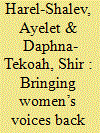

|
|
|
|
|
| Summary/Abstract |
In exploring wars and conflicts, Critical Security Studies and Feminist International Relations (IR) use various methodologies, including nontraditional avenues of inquiry. This study follows these theoretical and methodological perspectives and suggests a methodology that will contribute to contemporary debates in IR. Specifically, the study offers an innovative application of Carol Gilligan’s method, the “Listening Guide” (LG). The research demonstrates the utility of the LG analysis in uncovering additional forms of knowledge regarding armed conflicts. The context for analysis is women in combat. The implementation of the LG assists us in uncovering various voices, representing different aspects of the women combatants’ experiences in a conflict zone. In this study, this analytical tool, applied to conduct narrative research, enabled the researchers to hear both multiple and silenced voices. We suggest that this methodology should continue to be used in future studies and incorporated into the Security Studies and IR toolkit.
|
|
|
|
|
|
|
|
|
|
|
|
|
|
|
|
| 2 |
ID:
121906
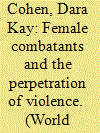

|
|
|
|
|
| Publication |
2013.
|
| Summary/Abstract |
Much of the current scholarship on wartime violence, including studies of the combatants themselves, assumes that women are victims and men are perpetrators. However, there is an increasing awareness that women in armed groups may be active fighters who function as more than just cooks, cleaners, and sexual slaves. In this article, the author focuses on the involvement of female fighters in a form of violence that is commonly thought to be perpetrated only by men: the wartime rape of noncombatants. Using original interviews with ex-combatants and newly available survey data, she finds that in the Sierra Leone civil war, female combatants were participants in the widespread conflict-related violence, including gang rape. A growing body of evidence from other conflicts suggests that Sierra Leone is not an anomaly and that women likely engage in conflict-related violence, including sexual violence, more often than is currently believed. Many standard interpretations of wartime rape are undermined by the participation of female perpetrators. To explain the involvement of women in wartime rape, the author argues that women in armed group units face similar pressure to that faced by their male counterparts to participate in gang rape. The study has broad implications for future avenues of research on wartime violence, as well as for policy.
|
|
|
|
|
|
|
|
|
|
|
|
|
|
|
|
| 3 |
ID:
185258
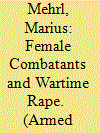

|
|
|
|
|
| Summary/Abstract |
Whereas existing research posits that the presence of female fighters in armed groups decreases their propensity for wartime rape, one recent study tests this claim quantitatively and is unable to detect a statistically significant effect. This leads the author to conclude that female combatants do not decrease rape. Using that study’s original data, this article reexamines the evidence for the relationship between female rebel combatants and wartime sexual violence. Replications of the original models suggest that they make strong functional form assumptions regarding numerous independent variables and time dependence and that relaxing them results in substantively different findings. Namely, women’s participation in armed groups decreases groups’ use of wartime rape. In support of Loken’s organizational theory of rape, results also suggest that this effect is moderated by group norms. These findings contribute to the literature on female participation in rebel groups and beyond.
|
|
|
|
|
|
|
|
|
|
|
|
|
|
|
|
| 4 |
ID:
172496
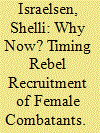

|
|
|
|
|
| Summary/Abstract |
Using case study evidence, this article demonstrates how the relationship between conflict intensity, gender inclusive ideologies and gender inclusive policies on one hand, and the decision to recruit female combatants on the other hand, is conditioned by the groups' conflict phase. Conflict phases divide conflict events into two distinct parts, the guerrilla activity phase and the civil war phase, contingent on the insurgents' number of armed fighters, military capabilities, level of institutionalization and degree of territorial control. These conflict phases affect the recruitment behavior of insurgent groups making them more likely to recruit female combatants in the civil war phase and less likely to do so in the guerrilla activity phase.
|
|
|
|
|
|
|
|
|
|
|
|
|
|
|
|
| 5 |
ID:
151114
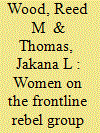

|
|
|
|
|
| Summary/Abstract |
Despite the frequent participation of women in armed groups, few studies have sought to explain the variation in their roles across different rebellions. Herein, we investigate this variation. We argue that the political ideology a group adopts plays a central role in determining the extent of women’s participation, particularly their deployment in combat roles. Specifically, we link variations in women’s roles in armed groups to differences in beliefs about gender hierarchies and gender-based divisions of labor inherent in the specific ideologies the groups adopt. We evaluate hypotheses drawn from these arguments using a novel cross-sectional dataset on female combatants in a global sample of rebel organizations active between 1979 and 2009. We find that the presence of a Marxist-oriented ‘leftist’ ideology increases the prevalence of female fighters while Islamist ideologies exert the opposite effect. However, we find little evidence that nationalism exerts an independent influence on women’s combat roles. We also note a general inverse relationship between group religiosity and the prevalence of female fighters. Our analysis demonstrates that political ideology plays a central role in determining whether and to what extent resistance movements incorporate female fighters into their armed wings.
|
|
|
|
|
|
|
|
|
|
|
|
|
|
|
|
|
|
|
|
|